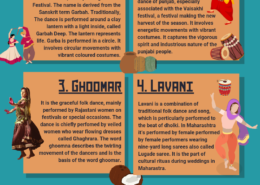In what ways can folk music function as a storytelling instrument to convey the history and cultural identity of different Indian regions?
Instruments play a crucial role in folk music traditions, serving not only as musical tools but also as reflections of local culture, history, and the resources available in a region. Here’s an analysis of how instruments contribute to the uniqueness of different folk music traditions across India:Read more
Instruments play a crucial role in folk music traditions, serving not only as musical tools but also as reflections of local culture, history, and the resources available in a region. Here’s an analysis of how instruments contribute to the uniqueness of different folk music traditions across India:
1. Cultural Significance
- Symbol of Identity: Instruments often embody the cultural identity of a community. For example, the dhol in Punjabi music is not just an instrument; it represents the vibrant agricultural lifestyle and communal celebrations of Punjab.
- Ritual and Tradition: Many instruments are closely tied to local rituals and ceremonies. The nadaswaram in South Indian weddings signifies auspiciousness and joy, reflecting its importance in cultural practices.
2. Resource Availability
- Local Materials: The choice of instruments often reflects the materials available in the region. For instance, bamboo flutes (such as the bansuri) are common in many parts of India where bamboo is abundant, while skin-covered drums like the mridangam are made from locally sourced animal hides.
- Craftsmanship: The skill and craftsmanship involved in making traditional instruments are rooted in local traditions. Artisans often use techniques passed down through generations, further linking the instrument to the cultural heritage of the region.
3. Musical Diversity
- Variety of Sounds: Different regions use distinct instruments that produce unique sounds reflective of local aesthetics. The ghungroo (ankle bells) in Kathak dance adds rhythmic complexity, while the khartal (clappers) in Rajasthani folk music provides a lively percussive element.
- Adaptation and Fusion: As cultures interact, instruments may blend, leading to new musical forms. For example, the sitar has been adapted in various regional folk styles, merging classical and folk elements, showcasing adaptability and creativity.
4. Functionality in Performance
- Role in Storytelling: Instruments often play a narrative role, accompanying lyrics that tell stories or convey messages. The dotara in Bengali folk music provides melodic support for songs that narrate historical or romantic tales.
- Community Engagement: Instruments facilitate community participation in music-making. The dandiya sticks in Garba not only provide rhythm but also involve dancers in an interactive and communal experience.
5. Seasonal and Thematic Associations
- Seasonal Instruments: Certain instruments are associated with specific seasons or agricultural cycles. For example, the shehnai, played during festive occasions and celebrations, is often linked to joyous events like weddings and harvest festivals.
- Thematic Representation: Instruments can also reflect the themes of the songs. The tumbi, with its bright and sharp sound, is often used in Bhangra, embodying the energetic spirit of celebration.
6. Evolution and Modernization
- Contemporary Influences: As folk music interacts with contemporary genres, instruments may evolve or be replaced by modern alternatives. For instance, electronic versions of traditional instruments are being used in fusion genres, demonstrating adaptability while still referencing cultural roots.
- Preservation Efforts: Communities actively work to preserve traditional instruments, ensuring that they are passed down to future generations. Workshops and initiatives to revive traditional craftsmanship highlight the importance of these instruments in maintaining cultural heritage.
Conclusion
In summary, instruments in folk music traditions are not only integral to the sound and rhythm of the music but also serve as rich symbols of local culture and resourcefulness. They reflect the unique characteristics of each region, embodying history, social practices, and community identity. Through their use, folk music becomes a dynamic expression of cultural heritage, continuously evolving while remaining deeply rooted in tradition.
See less

Folk music serves as a powerful narrative tool for expressing community history and cultural identity across various regions of India. Here’s how it fulfills this role: 1. Storytelling Tradition Historical Narratives: Folk songs often recount historical events, legends, and myths that shape the idenRead more
Folk music serves as a powerful narrative tool for expressing community history and cultural identity across various regions of India. Here’s how it fulfills this role:
1. Storytelling Tradition
2. Cultural Identity and Belonging
3. Reflection of Local Customs and Practices
4. Social Commentary and Awareness
5. Intergenerational Transmission
6. Unity and Social Cohesion
Conclusion
In summary, folk music serves as a vital narrative tool for expressing community history and cultural identity in various Indian regions. Through storytelling, reflection of local customs, and social commentary, it captures the essence of a community’s experiences and values. By facilitating intergenerational transmission and fostering social cohesion, folk music plays a critical role in preserving cultural heritage and promoting a sense of belonging among its practitioners.
See less